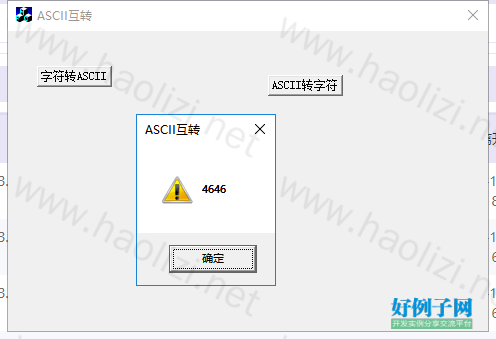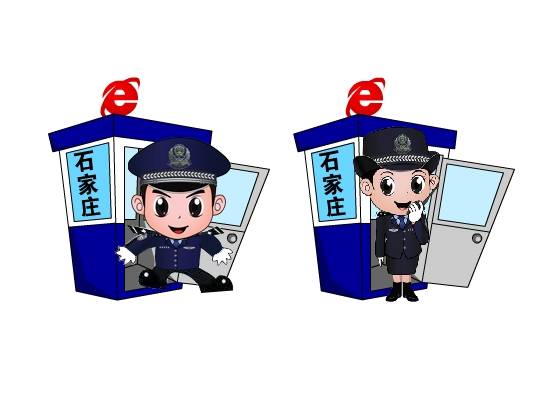实例介绍
【实例简介】
【实例截图】

【核心代码】
// ASCII互转Dlg.cpp : implementation file
//
#include "stdafx.h"
#include "ASCII互转.h"
#include "ASCII互转Dlg.h"
#ifdef _DEBUG
#define new DEBUG_NEW
#undef THIS_FILE
static char THIS_FILE[] = __FILE__;
#endif
/////////////////////////////////////////////////////////////////////////////
// CAboutDlg dialog used for App About
class CAboutDlg : public CDialog
{
public:
CAboutDlg();
// Dialog Data
//{{AFX_DATA(CAboutDlg)
enum { IDD = IDD_ABOUTBOX };
//}}AFX_DATA
// ClassWizard generated virtual function overrides
//{{AFX_VIRTUAL(CAboutDlg)
protected:
virtual void DoDataExchange(CDataExchange* pDX); // DDX/DDV support
//}}AFX_VIRTUAL
// Implementation
protected:
//{{AFX_MSG(CAboutDlg)
//}}AFX_MSG
DECLARE_MESSAGE_MAP()
};
CAboutDlg::CAboutDlg() : CDialog(CAboutDlg::IDD)
{
//{{AFX_DATA_INIT(CAboutDlg)
//}}AFX_DATA_INIT
}
void CAboutDlg::DoDataExchange(CDataExchange* pDX)
{
CDialog::DoDataExchange(pDX);
//{{AFX_DATA_MAP(CAboutDlg)
//}}AFX_DATA_MAP
}
BEGIN_MESSAGE_MAP(CAboutDlg, CDialog)
//{{AFX_MSG_MAP(CAboutDlg)
// No message handlers
//}}AFX_MSG_MAP
END_MESSAGE_MAP()
/////////////////////////////////////////////////////////////////////////////
// CASCIIDlg dialog
CASCIIDlg::CASCIIDlg(CWnd* pParent /*=NULL*/)
: CDialog(CASCIIDlg::IDD, pParent)
{
//{{AFX_DATA_INIT(CASCIIDlg)
// NOTE: the ClassWizard will add member initialization here
//}}AFX_DATA_INIT
// Note that LoadIcon does not require a subsequent DestroyIcon in Win32
m_hIcon = AfxGetApp()->LoadIcon(IDR_MAINFRAME);
}
void CASCIIDlg::DoDataExchange(CDataExchange* pDX)
{
CDialog::DoDataExchange(pDX);
//{{AFX_DATA_MAP(CASCIIDlg)
// NOTE: the ClassWizard will add DDX and DDV calls here
//}}AFX_DATA_MAP
}
BEGIN_MESSAGE_MAP(CASCIIDlg, CDialog)
//{{AFX_MSG_MAP(CASCIIDlg)
ON_WM_SYSCOMMAND()
ON_WM_PAINT()
ON_WM_QUERYDRAGICON()
ON_BN_CLICKED(IDC_BUTTON1, OnButton1)
ON_BN_CLICKED(IDC_BUTTON2, OnButton2)
//}}AFX_MSG_MAP
END_MESSAGE_MAP()
/////////////////////////////////////////////////////////////////////////////
// CASCIIDlg message handlers
BOOL CASCIIDlg::OnInitDialog()
{
CDialog::OnInitDialog();
// Add "About..." menu item to system menu.
// IDM_ABOUTBOX must be in the system command range.
ASSERT((IDM_ABOUTBOX & 0xFFF0) == IDM_ABOUTBOX);
ASSERT(IDM_ABOUTBOX < 0xF000);
CMenu* pSysMenu = GetSystemMenu(FALSE);
if (pSysMenu != NULL)
{
CString strAboutMenu;
strAboutMenu.LoadString(IDS_ABOUTBOX);
if (!strAboutMenu.IsEmpty())
{
pSysMenu->AppendMenu(MF_SEPARATOR);
pSysMenu->AppendMenu(MF_STRING, IDM_ABOUTBOX, strAboutMenu);
}
}
// Set the icon for this dialog. The framework does this automatically
// when the application's main window is not a dialog
SetIcon(m_hIcon, TRUE); // Set big icon
SetIcon(m_hIcon, FALSE); // Set small icon
// TODO: Add extra initialization here
return TRUE; // return TRUE unless you set the focus to a control
}
void CASCIIDlg::OnSysCommand(UINT nID, LPARAM lParam)
{
if ((nID & 0xFFF0) == IDM_ABOUTBOX)
{
CAboutDlg dlgAbout;
dlgAbout.DoModal();
}
else
{
CDialog::OnSysCommand(nID, lParam);
}
}
// If you add a minimize button to your dialog, you will need the code below
// to draw the icon. For MFC applications using the document/view model,
// this is automatically done for you by the framework.
void CASCIIDlg::OnPaint()
{
if (IsIconic())
{
CPaintDC dc(this); // device context for painting
SendMessage(WM_ICONERASEBKGND, (WPARAM) dc.GetSafeHdc(), 0);
// Center icon in client rectangle
int cxIcon = GetSystemMetrics(SM_CXICON);
int cyIcon = GetSystemMetrics(SM_CYICON);
CRect rect;
GetClientRect(&rect);
int x = (rect.Width() - cxIcon 1) / 2;
int y = (rect.Height() - cyIcon 1) / 2;
// Draw the icon
dc.DrawIcon(x, y, m_hIcon);
}
else
{
CDialog::OnPaint();
}
}
// The system calls this to obtain the cursor to display while the user drags
// the minimized window.
HCURSOR CASCIIDlg::OnQueryDragIcon()
{
return (HCURSOR) m_hIcon;
}
int hexStrToHexBuf(BYTE *src,int srcLen,BYTE *dest)
{
int i;
char n;
if(srcLen % 2 != 0) {
return 0;
}
memset(dest, 0, srcLen/2);
for(i=0; i<srcLen; i )
{
n = src[i];
if(islower(n)) { // a f -> A F
n = toupper(n);
}
n -= 0x30;
n = (n > 9) ? (n - 7) : n; // 16进制转为10进制数
if(i%2 == 0) {
dest[i/2] = n << 4;
} else {
dest[i/2] |= n;
}
}
return srcLen/2;
}
int hexBufToHexStr(BYTE *src, int srcLen, char * dest)
{
int i;
char n;
for(i=0; i<srcLen; i ) {
n = (src[i] & 0xF0) >> 4;
if(n <= 9) {
n = 0x30;
} else {
n = n - 10 'A';
}
dest[i * 2] = n;
n= src[i] & 0x0F;
if(n <= 9) {
n = 0x30;
} else {
n = n - 10 'A';
}
dest[i * 2 1] = n;
}
return srcLen * 2;
}
CString aTobcd(LPCTSTR src){
BYTE * Data;
char bResult[2000];
CString Result;
int dLen=strlen(src);
Data =(BYTE*)src;
hexBufToHexStr(Data,dLen,bResult);
Result=bResult;
return Result.Left(2*dLen);
}
CString bcdToa(LPCTSTR src)
{
BYTE * Data;
BYTE Result[2000];
CString resultstr;
int src_len;
Data = (BYTE *) src;
src_len = strlen(src);
hexStrToHexBuf(Data,src_len,Result);
resultstr = Result;
return resultstr.Left(src_len/2);
}
void CASCIIDlg::OnButton1()
{
// TODO: Add your control notification handler code here
CString WW;
WW="FF";
// AfxMessageBox(WW);
// GetDlgItemText(Txt_Display,WW);
WW=aTobcd(WW);
AfxMessageBox(WW);
}
void CASCIIDlg::OnButton2()
{
// TODO: Add your control notification handler code here
CString VALUE="4646";
VALUE=bcdToa(VALUE);
AfxMessageBox(VALUE);
}
好例子网口号:伸出你的我的手 — 分享!
小贴士
感谢您为本站写下的评论,您的评论对其它用户来说具有重要的参考价值,所以请认真填写。
- 类似“顶”、“沙发”之类没有营养的文字,对勤劳贡献的楼主来说是令人沮丧的反馈信息。
- 相信您也不想看到一排文字/表情墙,所以请不要反馈意义不大的重复字符,也请尽量不要纯表情的回复。
- 提问之前请再仔细看一遍楼主的说明,或许是您遗漏了。
- 请勿到处挖坑绊人、招贴广告。既占空间让人厌烦,又没人会搭理,于人于己都无利。
关于好例子网
本站旨在为广大IT学习爱好者提供一个非营利性互相学习交流分享平台。本站所有资源都可以被免费获取学习研究。本站资源来自网友分享,对搜索内容的合法性不具有预见性、识别性、控制性,仅供学习研究,请务必在下载后24小时内给予删除,不得用于其他任何用途,否则后果自负。基于互联网的特殊性,平台无法对用户传输的作品、信息、内容的权属或合法性、安全性、合规性、真实性、科学性、完整权、有效性等进行实质审查;无论平台是否已进行审查,用户均应自行承担因其传输的作品、信息、内容而可能或已经产生的侵权或权属纠纷等法律责任。本站所有资源不代表本站的观点或立场,基于网友分享,根据中国法律《信息网络传播权保护条例》第二十二与二十三条之规定,若资源存在侵权或相关问题请联系本站客服人员,点此联系我们。关于更多版权及免责申明参见 版权及免责申明



网友评论
我要评论